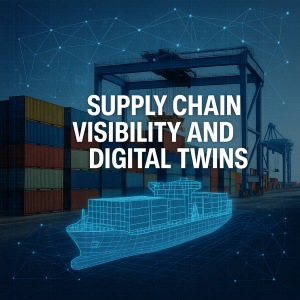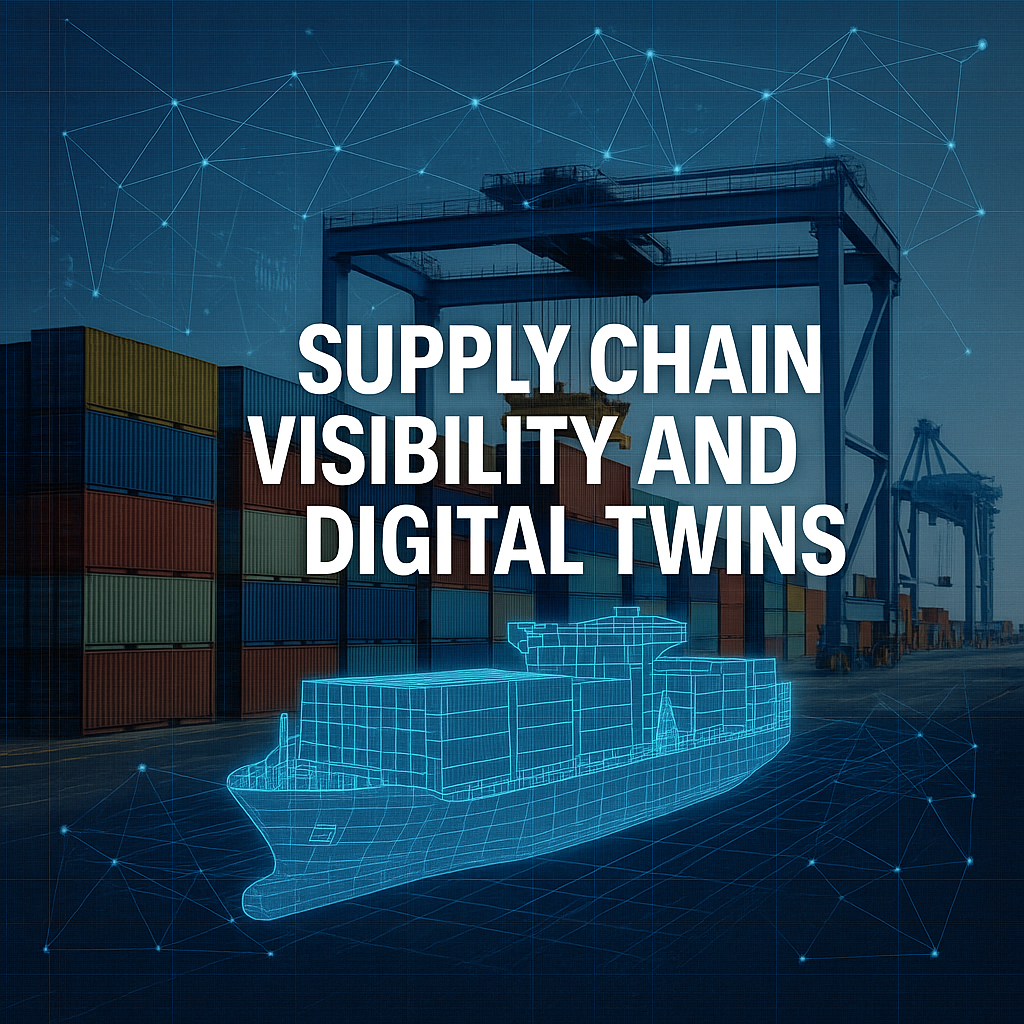
Discover how supply chain visibility and digital twin technology are transforming global trade. Learn how maritime logistics, digital replicas, and real-time tracking tools improve resilience, efficiency, and transparency across supply chains.
Why Visibility Matters in Global Supply Chains 🌍
Imagine shipping a container of medical equipment from Shanghai to Rotterdam. By the time it arrives, the goods may have passed through dozens of checkpoints: a factory, a regional warehouse, a feeder port, a transshipment hub, customs inspections, and an inland trucking leg. If one piece of the chain breaks—a port delay, a customs hold, a missing temperature-control record—the entire delivery is jeopardized.
For decades, global trade has suffered from a lack of transparency. Cargo often seemed to vanish once loaded on a vessel, with visibility restored only when it reached the next terminal. In today’s environment of geopolitical tensions, climate risks, pandemic disruptions, and customer expectations for speed, this is no longer acceptable.
This is where supply chain visibility and digital twin technology come into play. These innovations allow shippers, carriers, regulators, and even end-consumers to see in real time what is happening across their networks. They don’t just show where a container is—they simulate what might happen next, enabling proactive decisions.
For the maritime sector—responsible for carrying around 80% of global trade by volume (UNCTAD, 2023)—these tools are becoming a lifeline.
Why Supply Chain Visibility Matters in Modern Maritime Operations
Supply chains are often described as the “circulatory system of global trade.” If goods don’t move, economies stall. Visibility ensures that stakeholders can monitor, anticipate, and respond to risks before they spiral.
The Costs of Blind Spots
A lack of visibility can lead to:
-
Delays and congestion: A single late vessel can cascade into weeks of disruption at ports (ICS, 2022).
-
Financial losses: Untracked delays and spoilage cost billions annually, especially in perishables like seafood and pharmaceuticals.
-
Compliance risks: Increasing regulations—such as IMO’s GHG reduction targets and EU’s supply chain transparency laws—require documented traceability.
The Transparency Mandate
Customers today demand to know not just when their package will arrive but also where materials originated and how sustainably they were transported. Initiatives such as the EU Corporate Sustainability Reporting Directive (CSRD) and IMO’s Maritime Single Window (2024) reinforce this shift toward transparent, auditable logistics.
In this sense, supply chain visibility is no longer a luxury. It is a regulatory, financial, and reputational necessity.
Digital Twins: Replicas That Breathe Life into Data
While visibility tells us where we are, digital twins allow us to test where we could go.
What Is a Digital Twin?
A digital twin is a virtual replica of a physical object, process, or network. In supply chains, this means creating a mirror model of the entire logistics system—from factory to port to ship to final delivery.
For example:
-
A ship’s digital twin can simulate fuel efficiency under different routes or weather conditions.
-
A port’s digital twin can model berth allocation, crane utilization, and truck congestion.
-
A supply chain digital twin can forecast disruptions if a supplier shuts down, a storm hits the Suez Canal, or a geopolitical embargo arises.
Why It Matters
Unlike static dashboards, digital twins are dynamic and predictive. They ingest data from IoT sensors, AIS vessel tracking, ERP systems, customs databases, and weather feeds. They can then run what-if scenarios, helping decision-makers act before disruptions occur.
McKinsey estimates that companies with strong supply chain digital twins can reduce inventory by up to 25% and shorten order cycle times by 30–40% (McKinsey, 2022).
Key Technologies Driving Visibility and Digital Twins
1. Internet of Things (IoT) and Smart Sensors
Refrigerated containers now come with IoT-enabled trackers monitoring temperature, humidity, and shocks. For pharmaceuticals, this ensures that vaccines or insulin remain safe throughout their voyage.
2. Satellite and AIS Tracking
Platforms like MarineTraffic and VesselFinder use AIS signals to provide real-time vessel positions. When integrated into supply chain dashboards, shippers can see exactly where cargo is at sea.
3. Blockchain for Secure Records
Blockchain-based platforms like TradeLens (Maersk/IBM, though recently sunset, paving the way for new entrants) provide tamper-proof records of each handoff, building trust in documentation such as bills of lading.
4. AI and Predictive Analytics
Artificial Intelligence detects anomalies in shipment times, forecasts port congestion, and even predicts how weather patterns like El Niño might affect Pacific shipping routes.
5. Cloud and Edge Computing
Digital twins require immense computational power. Cloud platforms enable real-time simulation across thousands of scenarios, while edge devices process sensor data directly at ports or ships for speed.
Challenges on the Horizon—and Their Solutions
Data Fragmentation
Supply chain data is scattered across carriers, customs, and forwarders. Without interoperability, visibility becomes a patchwork.
Solution: Initiatives like IMO’s Maritime Single Window and EU’s Digital Transport Corridors promote standardized data exchange.
Cybersecurity Risks
With more data flowing through digital systems, the risk of cyberattacks grows.
Solution: Classification societies like DNV now certify cyber-secure ship and port systems, ensuring resilience.
Costs of Implementation
Small and medium-sized operators may lack resources to adopt advanced digital twins.
Solution: Regional programs (e.g., EU’s CEF Digital) and industry collaborations are making platforms more affordable through shared infrastructure.
Trust Among Stakeholders
Suppliers may resist transparency if it exposes competitive data.
Solution: Permissioned blockchain systems allow selective sharing, balancing openness with confidentiality.
Case Studies: Digital Twins in Action 🚢
Port of Singapore: A Nation’s Digital Heartbeat
Singapore has built one of the world’s most advanced port digital twins, integrating weather forecasts, vessel schedules, and crane operations. This has reduced berthing delays and cut emissions from idling ships (MPA Singapore, 2023).
Maersk and the Visibility Imperative
Though TradeLens was discontinued, Maersk continues to invest in supply chain visibility platforms, using predictive AI to forecast disruptions and offer customers estimated delivery updates with 95% accuracy.
Wärtsilä and Vessel Digital Twins
Marine engine giant Wärtsilä uses vessel digital twins to test fuel optimization strategies and simulate compliance with IMO’s CII and EEXI regulations—helping shipowners choose the most cost-effective retrofit path.
Future Outlook: Where Are We Headed?
-
AI-Driven Automation: Supply chain twins will increasingly be linked to autonomous decision-making, re-routing cargo without human intervention.
-
Sustainability Integration: Digital twins will not only trace goods but also calculate carbon footprints per shipment, vital for IMO’s decarbonization goals.
-
Global Collaboration: Expect more regional data-sharing initiatives, like the EU’s TEN-T digital corridors or the IMO’s GISIS platform, to expand.
-
Consumer Transparency: QR codes on retail goods may one day let consumers trace their product’s entire journey—from raw material to final delivery.
FAQ: Supply Chain Visibility and Digital Twins
1. What is the difference between supply chain visibility and digital twins?
Visibility shows real-time status; digital twins simulate scenarios for predictive decision-making.
2. Are digital twins only for large companies?
No. While early adopters were giants like Maersk, SMEs are increasingly accessing shared or cloud-based platforms.
3. How does this help sustainability?
By identifying inefficiencies, digital twins can reduce fuel consumption, optimize routes, and calculate emissions for compliance reporting.
4. Are there risks of over-reliance on digital tools?
Yes. If systems are hacked or data is poor, decisions may be flawed. That’s why cybersecurity and data quality controls are crucial.
5. Will regulators enforce visibility requirements?
Yes. The IMO, EU, and national authorities are increasingly mandating digital reporting, carbon tracking, and transparency in sourcing.
6. Can visibility prevent future crises like the Suez Canal blockage?
It cannot prevent them, but it can reduce impact by instantly showing which cargo is affected and simulating alternative routes.
7. What skills will maritime professionals need?
Beyond seamanship, digital literacy in AI tools, IoT systems, and data analytics will be vital for the next generation of officers and logisticians.
Conclusion: Sailing Toward a Transparent Future
The oceans may still hold mysteries, but maritime supply chains should not. With digital twins and real-time visibility tools, the industry is finally shedding its reputation for opacity. These technologies are reshaping how goods are traced, risks are managed, and sustainability is pursued.
As maritime professionals, students, and enthusiasts, embracing these tools means joining the journey toward a supply chain that is not only efficient but also resilient, transparent, and sustainable. The ships of the future will carry not just cargo, but also streams of data that tell the full story of global trade.
The question is no longer whether to adopt digital twins and visibility platforms—it is how fast we can sail into this new era.

